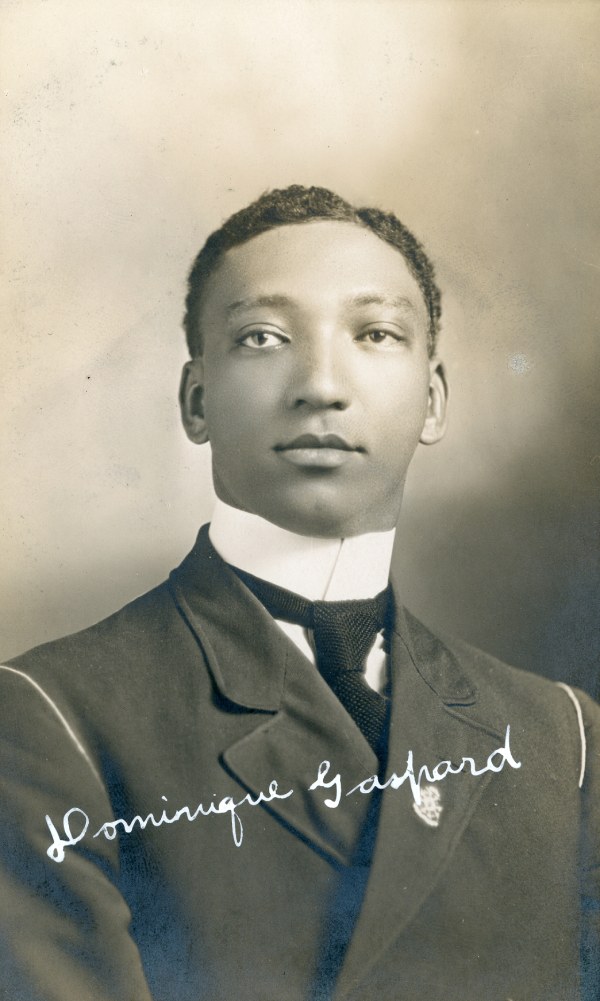Dominique François Gaspard (1884–1938) National Historic Person

© Centre d’histoire de Saint-Hyacinthe / Fonds CH001 Séminaire de Saint-Hyacinthe
Dr. Dominique François Gaspard was designated as a national historic person in 2024.
Historical importance: highly educated doctor of African descent who lived a life of service that bridged barriers of race, language and class in early 20th century Canada.
Commemorative plaque: no plaque installedFootnote 1
Dr. Dominique François Gaspard (1884–1938)
Historical language advisory: the following text contains historical language and content, including terms commonly used in 19th- and 20th-century Canada to refer to people of African descent, that some may find offensive and are now widely considered to be derogatory.
The unique story of Dr. Dominique François Gaspard sheds light on the religious, linguistic, and ethnocultural diversity of the people of African descent in early-20th-century Canada. Unlike most African Americans in Quebec at the time, he was born in New Orleans, Louisiana, to an Afro-French Creole family. He lived a life of service that bridged barriers of race, language, and class, volunteering for the Canadian Army Medical Corps during the First World War and then opening a medical practice in Montréal that served all. He stands out as a highly educated, bilingual, Catholic man within a largely anglophone and working-class community, which adds complexity and nuance to understandings of Black history.
Dominique and his twin brother, Barthelmi (sometimes spelled Barthélémy), were born in New Orleans on 22 December 1884 to Esther and John Gaspard. In 1905, Dominique Gaspard left New Orleans to study at the Séminaire de Saint-Hyacinthe, roughly 60 kilometres east of Montréal, Quebec. One of the earliest secondary schools in Quebec, it had been educating students of African ancestry since at least the 1860s. In 1910, Gaspard published a rare account of African American Catholic students’ experiences. After he completed his studies in 1911, Gaspard considered joining the Dominican order before enrolling as a medical student at Université Laval in Montréal in 1912.
During the First World War, Gaspard suspended his studies to enlist in the Canadian Expeditionary Force. From March 1915 to July 1917, he served with No. 4 Stationary Hospital (later No. 8 General Hospital), which was part of the Canadian Army Medical Corps. He was among the 103 members of No. 4 Stationary Hospital who travelled to France in November 1915 aboard SS Victoria. They took over the site of a former racetrack at Saint-Cloud, just outside Paris, and set to work building their own facilities, digging sewage trenches and constructing wooden huts, each named after a Canadian location. Gaspard was promoted to corporal and then sergeant, and received La Médaille des épidémies du ministère de la Guerre from France in April 1917. He served with No. 8 General Hospital until July 1917, when he returned to Canada to complete his medical studies.
Gaspard graduated from Laval in the spring of 1918 and lived the rest of his life in the Montréal area as part of a trailblazing first generation of doctors of African descent. He played an active role in the community, joining the congregation of the Union United Church and the local division of the Universal Negro Improvement Association in 1920. He helped found the Negro Community Centre with his wife Ethel May Lyons in 1927, and the Coloured War Veterans’ Legion (Quebec no. 50) in 1935. The first and only Legion branch exclusively for Canadian veterans of African descent, it was renamed the Dr. Gaspard Royal Canadian Legion Branch No. 50 in his honour in 1953. Gaspard died on 6 February 1938, following a short illness.
“Our Legacy Voices Veterans and Not Just Numbers (NJN) Census projects were delighted to team up to research the rich Canadian story of First World War veteran Dr. Dominique Gaspard. We are thrilled that he has been designated a person of national historic significance and look forward to having his legacy be part of the school curriculum in Canada.”
“The Government of Canada's recognition of Dr. Dominique Gaspard as a person of historical significance is noteworthy. Dr. Gaspard played an important role in the early Black community of Montreal. He helped to establish key organizations for the betterment of the city’s small English-speaking Black community. Language was not a barrier, which enabled this fully bilingual, African American to provide medical care to any in need. Dr. Gaspard had served in the First World War and was decorated for his exceptional service. His special connection to Black veterans was acknowledged even years after Dr. Gaspard’s untimely death. At their request, the local Legion renamed the Coloured War Veterans’ (Quebec no. 50) Branch to the Dr. Gaspard Royal Canadian Legion Branch no. 50. His life of service in the fledgling Black community was unique, and the recognition of Montreal’s early leaders is welcomed.”
This press backgrounder was prepared at the time of the Ministerial announcement in 2024.
The National Program of Historical Commemoration relies on the participation of Canadians in the identification of places, events and persons of national historic significance. Any member of the public can nominate a topic for consideration by the Historic Sites and Monuments Board of Canada.
- Date modified :